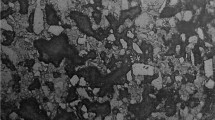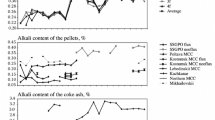Conclusions
In the service of blast furnace hot blast stoves the lining and checkerwork fail in individual zones as the result of deformation of the refractories, formation of cracks, and chemical corrosion of the lining under the action of low-melting dust at high temperatures.
It was shown that the deformation of aluminosilicate refractories depends not only upon temperature, load, and hold but also to a large degree upon the physicochemical properties of the parts, especially upon the composition and quantity of impurities.
On the basis of an analysis of the service of refractories in hot blast stoves recommendations were developed on differentiated use of refractories in the different zones of the lining and checkerwork.
For lining of the walls and the checkerwork of high-temperature hot blast stoves operating with a blast temperature up to 1300°C (temperature under the crown 1500–1550°C) the use of the following forms of refractories (GOST 20901-75) is recommended: 1550−1200°C temperature zone — type DV dinas parts; 1200−1100°C temperature zone — type MKV-72 mullite-corundum parts; 1100−900°C temperature zone — type ShV-42 chamotte parts; 900−700°C temperature zone — type ShV-37 chamotte parts; 700−400°C temperature zone — type ShV-28 chamotte parts.
To line the lower portion of the combustion chamber mullite-corundum parts of types MK-80 to Technical Specification 14-8-405-82 or MKV-72 must be used.
Lining of the crown, the inner wall of the combustion chamber, the hot blast lines, and the gas burners must be done with mortars corresponding to the types of refractories used (dinas and VT-1) with the addition of 10–12% orthophosphoric acid.
Type MKRP-340 mullite-silica fiber parts to GOST 23619-79 and other fiber materials are recommended for use as the compensation gap filler up to temperatures of not higher than 1150°C, and asbestos-vermiculite plates to GOST 13450-68 in the up to 600°C temperature zone.
The shell of the hot blast stove in the high temperature zone must be covered with thermal-insulation gunited concrete.
Similar content being viewed by others
Literature cited
Yu. P. Volkov, M. B. Kutner, and N. N. Podkantor, Review of Information/Ferrous Metallurgy Information [in Russian], Ser. 4, No. 4 (1974).
N. V. Pitak, E. A. Gin'yar, and I. F. Usatikov, Ogneupory, No. 1, 23–32 (1972).
V. D. Tsigler, V. L. Bulakh, I. D. Sizov, et al., Ogneupory, No. 9, 7–12 (1972).
V. A. Ustichenko, V. V. Primachenko, T. V. Ivashchenko, et al., Physicochemical Processes in the Production and Use of Refractories: A Subject Industry Collection/Ukrainian Scientific-Research Institute for Refractories [in Russian], Metallurgiya, Moscow (1981), pp. 16–20.
N. V. Pitak, V. S. Shapovalov, V. A. Ustichenko, et al., The Production of Special Refractories: A Subject Industry Collection/The Ukrainian Scientific-Research Institute for Refractories [in Russian], Metallurgiya, Moscow (1979), pp. 25–32.
I. F. Usatikov, N. V. Pitak, and E. A. Gin'yar, Ogneupory, No. 11, 32–36 (1973).
Author information
Authors and Affiliations
Additional information
Translated from Ogneupory, No. 7, pp. 44–50, July, 1986.
Rights and permissions
About this article
Cite this article
Pitak, N.V., Bulakh, V.L. Differentiated use of refractories in blast-furnace hot blast stoves. Refractories 27, 420–426 (1986). https://doi.org/10.1007/BF01389510
Issue Date:
DOI: https://doi.org/10.1007/BF01389510




